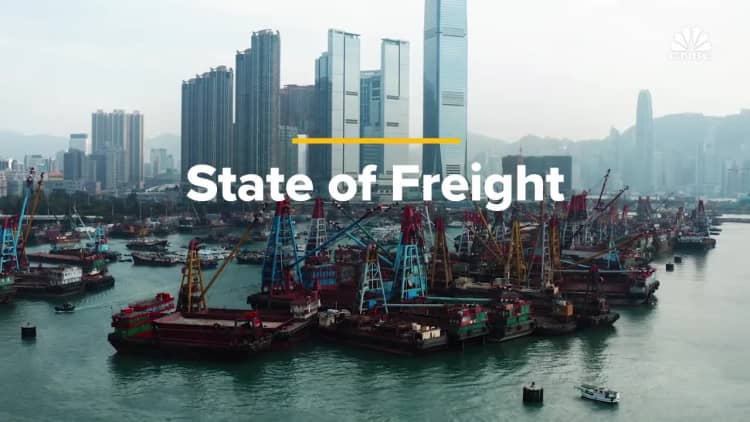A container crane stands idle at the Port of Los Angeles amid a cargo slowdown on November 16, 2022 in Los Angeles, California. The country’s busiest container port complex, the ports of Los Angeles and neighboring Long Beach, saw imports of shipping containers drop 26 percent in October compared with the same month in 2021.
Mario Tama | Getty Images News | Getty Images
The Port of New York and New Jersey took the top spot in the country for trade the month of October, the third-consecutive month it has topped California’s big ports as more cargo volume shifts to the East Coast.
New York handled 792,548 twenty-foot equivalent units (TEUs), nearly 19% more than in October 2019.
Earlier this week, the Port of Los Angeles posted its lowest level of October since 2009. Port of Los Angeles executive director Gene Seroka cited protracted negotiations and fears of a labor strike among port workers as the reason for the shift in trade at a press conference earlier this week. For the last three months, the Port of LA has also trailed behind the Port of Long Beach.
Logistics managers have been saying for months that trade was being redirected due to the labor issues at West Coast ports and several links in the transportation network, including rails, have begun using new models to route shipments across the country based on changes in port usage.
The labor situation on the West Coast remains uncertain.
While talks between the International Longshore and Warehouse Union and the Pacific Maritime Association are expected to resume as soon as this week, the resumption offers little clarity on the progress of negotiations, according to an analysis provided to CNBC by a spokesperson at supply chain research firm Everstream Analytics. It warns that despite beginning talks in May 2022, the two sides seem farther than ever from reaching an agreement.
Workers affiliated with the ILWU have undergone two walkouts at the Port of Oakland since the beginning of November, moves that the Everstream spokesperson said are widely regarded as tactics to put pressure on the PMA to make progress in the negotiations.
Despite falling cargo volumes on the West Coast, Everstream says the labor actions at both the ports of Oakland and Seattle have decreased productivity, leading carriers to divert volumes to Canadian ports on the West Coast.
“Two fundamental reasons explain the record-breaking number of boxes being processed by the Port of New York/New Jersey,” said Josh Brazil, vice president of supply chain insights for Project44, which is tracking the containers. “Firstly, shippers are still avoiding the West Coast to mitigate the risk of labor strikes at LA and Long Beach. Secondly, European imports to the East Coast are also very high.”
According to Project44 data, total vessel TEU capacity deployed from Europe to the East Coast is up 15.5% compared to Oct 2021.
Vessel cargo waits decline as economy, consumer weaken
Even as the East Coast rises as a port competitor, it is not immune from a slowing global economy and weaker consumer. CNBC Supply Chain Heat Map providers warned in the summer and fall of a decrease in manufacturing orders which has impacted the volume of shipping. The lesser container volumes are now being seen off the ports across the East Coast, including New York and New Jersey.
While the holiday season is just around the corner, Alex Charvalias, MarineTraffic’s supply chain in-transit visibility lead, said the New York port is facing a record-low average waiting time for container capacity “off port limits.” Its data shows this number dropping since week 42, when it was at 84,694 TEUs, to 28,340 TEUs in week 45.
Rick Cotton, executive director for the Port of New York and New Jersey, told CNBC initial ocean bookings for the port in November show “a definite softening,” but he added that it looks “seasonal; nothing surprising. We would expect to maintain our high volumes on a comparative basis and we do not see anything that would change that.”
The Port of Savannah, which has also been moving record volumes, is seeing a decrease in vessels waiting, with 17 vessels waiting an average of 2.9 days this week.
The Port of Houston has 14 vessels off the port waiting 4.9 days.
The decrease in orders has prompted an increase in cancellation of sailings and issues for U.S. exports with less ships coming to domestic ports.
The redirection of sea trade to the East Coast and increased use of rail to move ocean cargo West is another factor.
“We are experiencing challenges with exports being brought to West Coast ports from the east via rail,” said Paul Brashier, vice president, drayage and intermodal at ITS Logistics. “Those challenges are container high dwell time and the volumes in storage. Containers are missing the original vessels and rolling to the next vessel. The increased transit times on rail and the limited amount of vessels calling West Coast ports because of volumes declining due to potential labor unrest are the largest contributing factor to the volume of extended dwell containers,” he said.
The CNBC Supply Chain Heat Map data providers are artificial intelligence and predictive analytics company Everstream Analytics; global freight booking platform Freightos, creator of the Freightos Baltic Dry Index; logistics provider OL USA; supply chain intelligence platform FreightWaves; supply chain platform Blume Global; third-party logistics provider Orient Star Group; global maritime analytics provider MarineTraffic; maritime visibility data company Project44; maritime transport data company MDS Transmodal UK; ocean and air freight rate benchmarking and market analytics platform Xeneta; leading provider of research and analysis Sea-Intelligence ApS; Crane Worldwide Logistics; DHL Global Forwarding; freight logistics provider Seko Logistics; Planet, provider of global, daily satellite imagery and geospatial solutions, and ITS Logistics provides port and rail drayage services in 22 coastal ports and 30 rail ramps throughout North America.

 EU News Digest Latest News & Updates
EU News Digest Latest News & Updates



